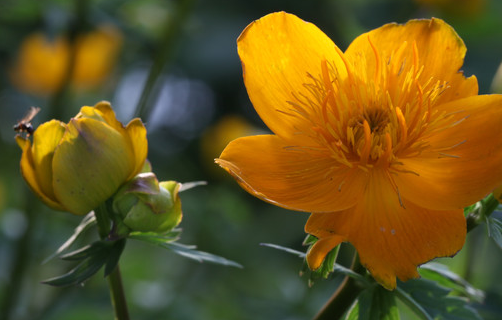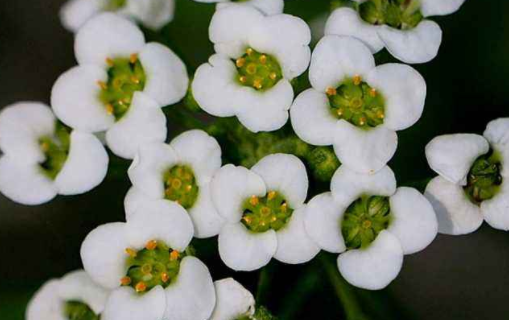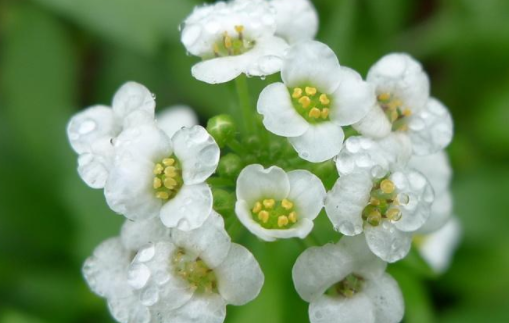How to raise Golden Lotus
Soil
Golden Lotus for the soil is still relatively high requirements, choose soil to choose organic-rich sandy loam, if you can, it is best to measure the soil PH value, if the PH value between 5-6, that is the best, there is to add some organic fertilizer as the base fertilizer in the soil, so as to make the soil more fertile and more conducive to plant growth.

Temperature
Golden Lotus does not like the warm environment, it likes to grow in a relatively low temperature environment, its most suitable growth environment is between 10 ℃ ~ 15 ℃, but in winter, the temperature is too low, so even if the golden lotus is more hardy, it should be moved indoors for maintenance.
Watering
Golden Lotus is relatively strict for watering, because it likes a wet environment, so it should always keep the soil moist and the environment around the plant moist, but not too much watering, otherwise the root system of the plant will rot.
Fertilizer application
The fertilization of the golden lotus seedlings can be applied every 10 days, and the fertilization should be reduced as far as possible, and water and fertilizer can be applied every 20 days or so. However, we should pay attention to the fact that fertilizer and water can be applied every 7-10 days before the golden lotus blossoms to make the flowers more colorful, but too much fertilization will burn the seedlings, oh, pay attention to this.
How to cultivate anemone how to cultivate anemone
Honeysuckle is a perennial floating-leaf herb, which has a strong ability to adapt to the environment and is also suitable for viewing. Let's follow the editor of the wed114 marriage network to see how to raise anemone and introduce you to this plant and the breeding method of anemone.
Introduction of anemone
Nymphoides indica (L.) O. Kuntze): perennial aquatic herbs. Stem cylindrical, unbranched, shaped like petiole, terminal simple leaf. Leaves floating, subleathery, broadly ovoid or suborbicular, densely glandular below, base cordate, entire, with inconspicuous palmate veins, petiole short, Terete, flowers numerous, clustered nodes, pedicels slender, Terete, unequal, divided near base, lobes long elliptic to lanceolate, apex obtuse, veins inconspicuous Corolla white, base yellow, divided to near base, Corolla tube short, lobes ovate-elliptic, apex obtuse, ventral densely fimbriate villous. Capsule oval, flowering and fruiting from August to October.
Anemone produces 50-1530 meters above sea level and is widely distributed in the tropics to temperate zones of the world. Distributed in Northeast China, East China, South China, Hebei, Yunnan.
1. Morphological characteristics
Stem: anemone is a perennial aquatic herb. Stem cylindrical, unbranched, shaped like petiole, terminal simple leaf.
Leaves: leaves of anemone floating, subleathery, broadly ovoid or suborbicular, 3-18 cm long, densely glandular below, base cordate, entire, with inconspicuous palmate veins, petiole short, Terete, 1-2 cm long.
Flowers: anemone flowers numerous, clustered at nodes, 5-numbered; pedicel slender, Terete, unequal, 3-5 cm long; calyx 3-6 mm long, divided to near base, lobes long elliptic to lanceolate, apex obtuse, veins obscure. Corolla white, yellow at base, 7-12 mm long, 6-8 mm in diameter, divided to near base, crown tube short, with 5 bunches of villous, lobes ovate-elliptic, apex obtuse, ventral densely fimbriate villous; stamens inserted on crown tube, neat, filaments short, flattened, linear, 1.5-1.7 mm long, anthers arrow-shaped, 2-2.2 mm long Ovary sessile, conic, 2 mm long, style stout, Terete, ca. 2.5 mm, stigma dilated, 2-lobed, lobes triangular.
Fruit: capsule of anemone ellipsoid, 3-5 mm long, indehiscent; seeds swollen, brown, subglobose, 1.2-1.5 mm long, smooth. Chromosome 2n=18. The flowering and fruiting period of anemone is from August to October.
2. Ecological habits
The anemone prefers a warm and humid climate. The optimum temperature for plant growth and development was 20-35 ℃. When the temperature was higher than 40 ℃ or lower than 15 ℃, the plant did not blossom or stagnated. It can adapt to a wide range of acids and bases. Often live in lakes and ponds and rivers.
How to raise the anemone
I. Culture methods
Honeysuckle and ordinary aquatic plants, there are no special requirements, generally keep the water relatively clean.
1. Pool
The water depth is about 40 cm, and the pot water depth is about 10 cm. With ordinary pond mud as the substrate, it should not be too fat, otherwise the branches and leaves are luxuriant and the flowering is rare. If the leaves turn yellow, a small amount of compound fertilizer or chemical fertilizer tablets can be buried in the basin. Usually keep plenty of sunshine, do not lack of water in the basin, otherwise it is also easy to dry up.
2. Potted plants
Depending on the size of the basin and the crowding of plants, the basin should be divided every 2-3 years. Keep water in the basin in winter, and you can survive the winter by putting it in a leeward and sunny place. The winter temperature in northern China is relatively low, so overwintering treatment should be carried out when cultivating anemone.
3. Fertilization
In order to promote the growth and development of the anemone plant and improve its ornamental effect, weeds and debris should be removed in time during the growing period of the anemone plant, keep the water clean, and apply fertilizer 1-2 times combined with weeding.
Second, the mode of reproduction
Propagation by ramet and cuttage
Ramet divides the dense growth clump into small clumps and replanted in March every year; cutting propagation is also easy to survive, and all its nodes can take root on the stem. 2-4 branches are taken from the growing period, and the cuttings are in shallow water and take root two weeks later. When a new plant is formed at the place where the petiole is planted, it can reproduce asexually, but the seeds can also be soaked in 22-25 ℃ water temperature to accelerate germination.
III. Disease prevention and control
The main pest of anemone is aphids, and the control effect can be achieved by spraying 40% dimethoate emulsion 1000 times.
How to raise Golden Lotus well
Golden lotus, also known as dry lotus, dry lotus, etc., although the appearance of golden lotus is not very eye-catching, but golden lotus has a certain medicinal value, can clear away heat and detoxification. If you are also interested in cultivating Golden Lotus, don't miss the notes on the cultivation of Golden Lotus sorted out by the editor for you.
Golden lotus
Golden lotus is cultivated all over the country. It likes warm, moist and sunny environment, avoids cold (the lowest temperature is no less than 10 ℃), is slightly resistant to drought, and is lax in soil requirements. Reproduction is mainly by sowing and reproduction. In autumn, the newly collected seeds can be sown in a dry and ventilated place to dry. Full, dry seeds can also be selected in early spring, soaked in 20 to 30 ℃ of warm water for 1 to 2 hours, removed and sown.
The seedbed should be shaded and ventilated, and the seeds should be covered with soil. buds can grow in about a week. Can also be propagated by cutting, select a strong and full stem at the beginning of summer, cut the cuttings with a length of 10 cm-15 cm, and insert them in a sand or perlite bed with good water permeability and permeability, pay attention to shading and maintain air humidity, and take root and send leaves for transplanting in about 15 days.
The transplanted seedlings need to be pinched for many times to prevent the overgrowth of plants. Make the plant plump and beautiful. As Clematis paniculata is a vine, it is easy to reshape, so it can be dragged to the appropriate part for plastic surgery. Dry stems, leaves and blooming flowers should be cut off in time to facilitate ventilation, reduce nutrient consumption and maintain a beautiful shape.
Attention should be paid to the application of more phosphorus and potash fertilizer at the seedling stage, sufficient sunshine during the growing period, and frequent ploughing and weeding has improved soil permeability. Thin fertilizer should be applied frequently at the flower bud stage. After each choking, phosphorus and potash fertilizer should be applied properly to promote the flowering of new shoots. Nelumbo nucifera leaves like lotus leaves, calyx base United into a tube, so that the whole flower seems to surface, bright flowers standing in the lotus leaf-like leaves, bustling, forming a beautiful picture. In the aspect of landscaping, it is mainly used for the greening of metope, balcony and fence, and can also be used to decorate flower beds. It is very easy to cultivate and maintain, and can be self-sown and multiply. Golden lotus can also be eaten. In the United States, it is regarded as Chinese chili pepper, and it is a popular food. You can also use its tender stem at the top with a little seasoning to eat it, and it tastes delicious.
- Prev

How to raise fragrant snowballs
Temperature fragrant snowball likes to grow in a cold environment, it does not like hot weather, the temperature requirements in winter is not very strict, as long as there is no frost, the plant can survive the winter safely. The temperature is too high in summer, so we should pay attention to cooling it, if the temperature is above 30 degrees.
- Next

Notes on the cultivation of fragrant snowballs
Pay attention to pruning. In the process of blooming, you can cut off the remaining flowers with three leaves, which can prolong the flowering period of fragrant snowballs.
Related
- Fuxing push coffee new agricultural production and marketing class: lack of small-scale processing plants
- Jujube rice field leisure farm deep ploughing Yilan for five years to create a space for organic food and play
- Nongyu Farm-A trial of organic papaya for brave women with advanced technology
- Four points for attention in the prevention and control of diseases and insect pests of edible fungi
- How to add nutrient solution to Edible Fungi
- Is there any good way to control edible fungus mites?
- Open Inoculation Technology of Edible Fungi
- Is there any clever way to use fertilizer for edible fungus in winter?
- What agents are used to kill the pathogens of edible fungi in the mushroom shed?
- Rapid drying of Edible Fungi

